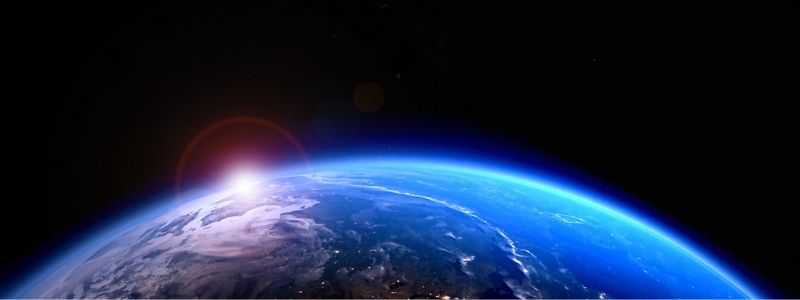-
Question of
According to NASA, how many layers are contained in the Earth’s atmosphere?

-
5
-
6
-
4
-
8
Correct Wrong
The Earth's atmosphere has five main layers: troposphere, stratosphere, mesosphere, thermosphere, and exosphere.
-
-
Question of
The densest layer of the atmosphere is called the troposphere, it contains 80% of the atmospheric weight.

-
 TRUE
TRUE -
 FALSE
FALSE
Correct Wrong
The troposphere is the densest layer of Earth’s atmosphere and holds about 80% of its total weight. It’s where all the action happens—like breathing, weather, and flying planes. Here’s an interesting fact: Even though it’s jam-packed with air, the troposphere is the shortest layer, stretching just 7 to 20 kilometers (4 to 12 miles) high. That’s less than the distance of a casual road trip, yet it’s keeping us all alive!
-
-
Question of
The atmosphere is about 500 km thick, with a mix of more than ten different gases. Which gas makes up 78% of the Earths atmosphere?

-
Nitrogen
-
Ogygen
-
Carbon Dioxide
-
Hydrogen
Correct Wrong
The atmosphere is indeed about 500 km thick (give or take, depending on where you measure up to the exosphere), and it’s a cocktail of over ten gases. The one that dominates, making up 78% of the mix, is nitrogen. Here’s an interesting fact: Nitrogen is super chill—it doesn’t react much, which is why it just hangs out in the air instead of causing drama like oxygen does with fire or rust. Plants and bacteria actually snag it from the air to help make stuff like proteins, so it’s quietly a big deal for life on Earth!
-
-
Question of
The Stratosphere contains the ozone belt/layer.

-
 TRUE
TRUE -
 FALSE
FALSE
Correct Wrong
The stratosphere does contain the ozone layer, a special zone where ozone (O₃) hangs out, soaking up harmful ultraviolet (UV) rays from the sun. Here’s an interesting fact: The ozone layer is like Earth’s sunscreen—it blocks about 97-99% of the sun’s UV radiation. Without it, we’d be frying like eggs on a sidewalk, and it’s mostly found between 15 and 35 kilometers (9 to 22 miles) up in the stratosphere.
-
-
Question of
The border that represents the separation between the atmosphere and outer space is called the Aurora line.

-
 TRUE
TRUE -
 FALSE
FALSE
Correct Wrong
The border between Earth’s atmosphere and outer space isn’t called the Aurora line—it’s actually the Kármán line, set at about 100 kilometers (62 miles) above sea level.
-
-
Question of
The thermosphere is the closest layer to the surface of the Earth.

-
 TRUE
TRUE -
 FALSE
FALSE
Correct Wrong
The thermosphere is so high up that it’s where the International Space Station orbits, and it can get crazy hot—up to 2,500°C (4,500°F)—because it absorbs intense solar radiation. But don’t worry, you wouldn’t feel the heat if you were there, since the air is so thin!
-
-
Question of
Most satellites orbiting Earth are found in the ionosphere.

-
 TRUE
TRUE -
 FALSE
FALSE
Correct Wrong
Actually, this one’s not quite true, so let’s tweak it: Most satellites orbiting Earth are not strictly in the ionosphere. The ionosphere is a region that overlaps parts of the upper atmosphere, mainly the thermosphere and some of the exosphere, from about 50 to 1,000 kilometers (31 to 621 miles) up. While some satellites do pass through it, most orbit in the thermosphere or higher, often above 200 kilometers, with many in Low Earth Orbit (LEO) around 300-2,000 kilometers.
-
-
Question of
During the Cambrian Period in the developmental history of the Earth, CO2 levels were up to 20 times higher than today.

-
 TRUE
TRUE -
 FALSE
FALSE
Correct Wrong
During the Cambrian Period (about 541 to 485 million years ago), CO2 levels were indeed much higher than today—estimates suggest they could have been 10 to 20 times higher than our current levels (today’s around 420 parts per million). This is based on scientific models and evidence like ancient rock records. Here’s an interesting fact: Despite those sky-high CO2 levels, the Cambrian Period was when life really started popping off—think of the “Cambrian Explosion,” where tons of weird, wild creatures like trilobites showed up. The extra CO2 might’ve warmed things up and fueled early oceans, giving life a big boost!
-
-
Question of
Because of decreased atmospheric pressure, water boils at about 70 degrees at the top of Mount Everest.

-
 TRUE
TRUE -
 FALSE
FALSE
Correct Wrong
At the top of Mount Everest, about 8,848 meters (29,029 feet) above sea level, the atmospheric pressure is way lower than at sea level—only about a third as much. This drop in pressure lowers the boiling point of water to around 70°C (158°F), compared to 100°C (212°F) down at sea level. Here’s an interesting fact: Climbers on Everest can’t even make a proper cup of tea at that boiling point—it’s too cool to brew it well or cook food thoroughly. So, they’ve got to rely on pressure cookers or just deal with lukewarm noodles while conquering the world’s tallest peak
-
-
Question of
Scientists have found many different types of microorganisms in the atmosphere. About 25 percent of the microbes were similar to those found in feces.

-
 TRUE
TRUE -
 FALSE
FALSE
Correct Wrong
Scientists have discovered a surprising variety of microorganisms floating floating around in the atmosphere, from bacteria to fungi, by sampling air at high altitudes. Studies, like one from 2013, found that about 25% of these airborne microbes share similarities with ones typically found in feces—yep, poop bacteria hitching a ride on the wind!
-
-
Question of
Earth’s magnetic field reaches 58,000 km into space. This region is called the Attractosphere.

-
 TRUE
TRUE -
 FALSE
FALSE
Correct Wrong
Earth’s magnetic field does extend far into space—about 58,000 to 65,000 km on the sunlit side, and even farther on the night side (up to hundreds of thousands of km)—but it’s not called the "Attractosphere." That’s not a real term. This region is actually called the magnetosphere.
-
-
Question of
Most commercial jets almost always fly within the Stratosphere.

-
 TRUE
TRUE -
 FALSE
FALSE
Correct Wrong
The stratosphere starts around 12 km (39,000 feet) up, and commercial jets typically cruise between 30,000 and 40,000 feet (9-12 km). So, they’re often just below or right at the edge of the stratosphere, dipping into the upper troposphere too. Saying "almost always" pushes it a bit far, so this leans false in that sense. Here’s an interesting fact: Flying near the stratosphere is awesome for jets because the air’s thinner and smoother up there—no bumpy storms like in the troposphere below. It saves fuel and keeps your in-flight coffee from spilling!
-